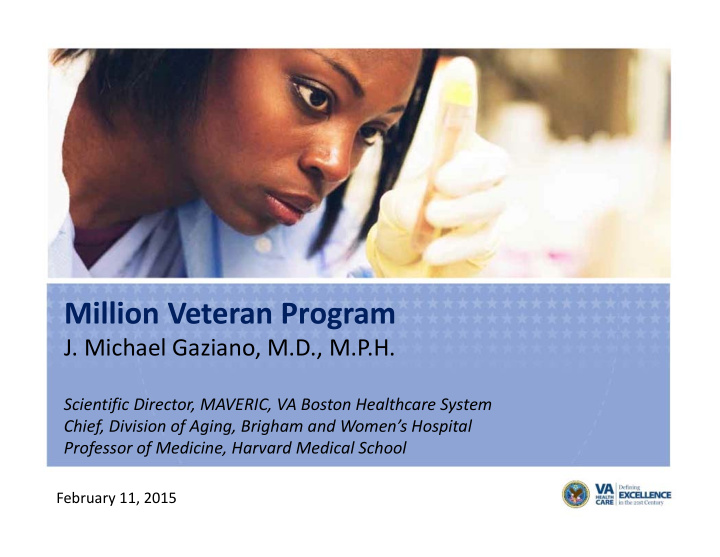



Million Veteran Program J. Michael Gaziano, M.D., M.P.H. Scientific Director, MAVERIC, VA Boston Healthcare System Chief, Division of Aging, Brigham and Women’s Hospital Professor of Medicine, Harvard Medical School February 11, 2015
Nesting Population Research in the VA Healthcare System VA ideal setting for nested large ‐ scale • population research – Stable and willing veteran population of 8 million using the system each year – Outstanding electronic medical record; fully integrated; data reaching back as far as 20 years; access to CMS and NDI data – Research infrastructure with diverse expertise – Prototypes for health system based research: – Pragmatic trial of HCTZ vs Chlorthalidone – Million Veteran Program VETERANS HEALTH ADMINISTRATION
Large ‐ Scale Biobanks Europe • North America • – Icelandic Biobank and deCODE – Vanderbilt University BioVU – UK Biobank – Canadian Consortium [Canada] – Banco Nacional de ADN [Spain] – dbGaP, NIH [US] – GenomEUtwin – National Children's Study [US] – Finnish biobank – Marshfield Clinic [US] – Swedish biobank – National Health and Nutrition – German biobank, KORA Examinations Surveys [US] – UK DNA Banking Network & British biobank – Kaiser Permanente Northern CA [US] – Estonian biobank: – Howard University African Diaspora – Family ‐ based collections [Nordic] [US] – Generation Scotland – Mayo Clinic – HUNT (cardiovascular)& Biohealth [Norway] – ACS – EPIC, European (cancer) – Danubian Biobank Consortium – GATiB Genome Austria Tissue Bank – Biobank Hungary VETERANS HEALTH ADMINISTRATION
Million Veteran Program (MVP) • Enroll up to one million users of the VHA into an observational mega ‐ cohort – Blood collection for storage in biorepository for future research – Collect self ‐ reported health and lifestyle information – Access to electronic medical record – Ability to recontact participants Million Veteran Program VETERANS HEALTH ADMINISTRATION
MVP Organizational Structure VETERANS HEALTH ADMINISTRATION
MVP Recruitment and Enrollment • Invitational Mailing/Appointment Mailing – Invitation letter, Baseline Survey, MVP Brochure – Appointment letter, Informed consent language • Walk ‐ in recruitment • Study visit – Informed consent/HIPAA – Blood collection • Thank You Mailing – Thank you letter, Lifestyle Survey Specimens sent daily • VETERANS HEALTH ADMINISTRATION
Automated Specimen Processing VETERANS HEALTH ADMINISTRATION 6
VA Central Biorepository VETERANS HEALTH ADMINISTRATION 7
Distribution of MVP Sites = Actively Recruiting = Closed to Recruitment VETERANS HEALTH ADMINISTRATION
MVP Recruitment to Date Invitation mailings sent 2.9 Million Expressed interest by mail 19.4% (11.2%/8.2%) Optout 13% Completed Baseline Surveys 456,000 Consented Veterans 349,000 Specimens in Lab 345,000 Unscheduled (proportion) 40% Upcoming appointments 5,000 Call volume Over 500,000 VETERANS HEALTH ADMINISTRATION
Current Lab Activities • Receiving and Processing ‐ 400 ‐ 600 per day • Shipping Samples for Sequencing and Genotyping: Assay Type Shipments to ‐ date Targeted Shipments Whole Genome 1886 1370 + 516 sequencing Whole Exome 24260 24126 sequencing SNP Genotyping 206,603 ~200,000 VETERANS HEALTH ADMINISTRATION 10
Axiom MVP Biobank Array 2/ 13 / 201 11 5
Million Veteran Program (MVP) Data Universe Biospecimen Self ‐ reported MVP surveys MVP Molecular Participant Data VA ‐ Clinical VINCI, VIReC, Non ‐ VA NDI, CMS, etc. VETERANS HEALTH ADMINISTRATION 12
Other Data Sources MVP Data Other Data Self ‐ Reported Survey Data: VA Healthcare System Data • • – Lifestyle Survey Data (Personal Other Data • Information, Well ‐ Being, Activity, – National Death Index (NDI) Health, Military Experience, – Centers for Medicare and Dietary Intak, Medication, Habits) Medicaid Services (CMS) – Baseline Survey (Health, Military – State Mortality Data Experiences, family medical history) Genetic Data • – Genotype data – Sequence data VETERANS HEALTH ADMINISTRATION 13
VA Data Sources Corporate Data Warehouse Clinic Inpatient and Outpatient Visits • • Databases Diagnosis (ICD ‐ 9) codes • National Patient Care Procedure (CPT) codes • • Databases National Pharmacy data and laboratory data • Vital Status Data • Systems Decision Support System • Pharmacy Benefit Management • (NDS) National Data Extract • (PBM) system database Beneficiary Identification • OEF/OIF and OND Roster • Special Records Locator (BIRLS) death VA Clinical Assessment Reporting • Data file and Tracking (CART) Access w/ New England VISN ‐ 1 Pharmacy • Veterans Affairs Surgical Quality Data • files Improvement Program (VASQIP) Steward Outpatient Clinic File (OPC) • Veterans Affairs Central Cancer • Patient Treatment File (PTF) Registry (VACCR) • Inpatient and Outpatient • Hospitalizations VETERANS HEALTH ADMINISTRATION 14
System Architecture Data Warehouse Study Mart Vendor Survey Data Analysis Study Environment Mart VA Clinical Data Study Mart Consent Non VA NDI, CMS Manager Query Query Molecular Mart Portal Molecular data Lab Access Authorization by Governance System Researcher VETERANS HEALTH ADMINISTRATION 15
MVP Phenotyping Activities Core Variables Complex Phenotypes Disease Demographics • • Myocardial infarction (MI) Age – – Stroke Sex – – Unstable angina with revascularization Race – – Acute congestive heart failure Laboratory values – • Death from cardiovascular disease Total cholesterol – – Vascular procedure HDL, LDL – – Posttraumatic stress disorder (PTSD) Albumin – – Schizophrenia Serum creatinine – – Bipolar disorder Triglycerides – – Traumatic brain injury Medications – • Depression Other characteristics – • Vascular dementia Blood pressure – – Cognitive impairment Height/weight/BMI – – Type 2 diabetes mellitus – Smoking – Other • Alcohol consumption – Creatinine trajectory Combat exposure – – Glucose tragectory – VETERANS HEALTH ADMINISTRATION 16 Algorithm Development Validation Methods
Step 1: Define initial working algorithm (T1A) Step 5: Derive T2A Step 2: Create study cohort and apply T1A Step 6: Evaluate T2A to formulate T3A Step 7: Develop probabilistic model and assign Step 3: Create Annotation Data Set caseness Step 4: Create Phenomic Database through Deposit resulting algorithms to a central Data Processing Pipelines Phenotype Library
Ongoing alpha and beta test projects Core MVP descriptive projects • – Characterization of the cohort – Race: EHR v. self report v. genes Alpha Test projects • – Schizophrenia/bipolar: Cases collected separately; controls from MVP – PTSD Beta test RFA • – LOIs – Full proposals due in March Projects in planning • VETERANS HEALTH ADMINISTRATION
Recommend
More recommend